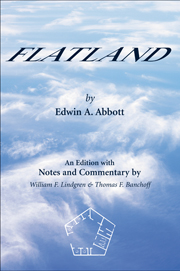Book contents
- Frontmatter
- Contents
- Acknowledgments
- Introduction
- Flatland with Notes and Commentary
- Part I This World
- 1 Of the Nature of Flatland
- 2 Of the Climate and Houses in Flatland
- 3 Concerning the Inhabitants of Flatland
- 4 Concerning the Women
- 5 Of our Methods of Recognizing one another
- 6 Of Recognition by Sight
- 7 Concerning Irregular Figures
- 8 Of the Ancient Practice of Painting
- 9 Of the Universal Colour Bill
- 10 Of the Suppression of the Chromatic Sedition
- 11 Concerning our Priests
- 12 Of the Doctrine of our Priests
- Part II Other Worlds
- Epilogue by the Editor
- Continued Notes
- Appendix A Critical Reaction to Flatland
- Appendix B The Life and Work of Edwin Abbott Abbott
- Recommended Reading
- References
- Index of Defined Words
- Index
3 - Concerning the Inhabitants of Flatland
Published online by Cambridge University Press: 05 August 2013
- Frontmatter
- Contents
- Acknowledgments
- Introduction
- Flatland with Notes and Commentary
- Part I This World
- 1 Of the Nature of Flatland
- 2 Of the Climate and Houses in Flatland
- 3 Concerning the Inhabitants of Flatland
- 4 Concerning the Women
- 5 Of our Methods of Recognizing one another
- 6 Of Recognition by Sight
- 7 Concerning Irregular Figures
- 8 Of the Ancient Practice of Painting
- 9 Of the Universal Colour Bill
- 10 Of the Suppression of the Chromatic Sedition
- 11 Concerning our Priests
- 12 Of the Doctrine of our Priests
- Part II Other Worlds
- Epilogue by the Editor
- Continued Notes
- Appendix A Critical Reaction to Flatland
- Appendix B The Life and Work of Edwin Abbott Abbott
- Recommended Reading
- References
- Index of Defined Words
- Index
Summary
The greatest length or breadth of a full-grown inhabitant of Flatland may be estimated at about eleven of your inches. Twelve inches may be regarded as a maximum.
Our Women are Straight Lines.
Our Soldiers and Lowest Classes of Workmen are Triangles with two equal sides, each about eleven inches long, and a base or third side so short (often not exceeding half an inch) that they form at their vertices a very sharp and formidable angle. Indeed when their bases are of the most degraded type (not more than the eighth part of an inch in size), they can hardly be distinguished from Straight Lines or Women; so extremely pointed are their vertices. With us, as with you, these Triangles are distinguished from others by being called Isosceles; and by this name I shall refer to them in the following pages.
Our Middle Class consists of Equilateral or Equal-sided Triangles.
Our Professional Men and Gentlemen are Squares (to which class I myself belong) and Five-sided Figures or Pentagons.
Next above these come the Nobility, of whom there are several degrees, beginning at Six-sided Figures, or Hexagons, and from thence rising in the number of their sides till they receive the honourable title of Polygonal, or many sided. Finally when the number of the sides becomes so numerous, and the sides themselves so small, that the figure cannot be distinguished from a circle, he is included in the Circular or Priestly order; and this is the highest class of all.
- Type
- Chapter
- Information
- FlatlandAn Edition with Notes and Commentary, pp. 26 - 33Publisher: Cambridge University PressPrint publication year: 2009



